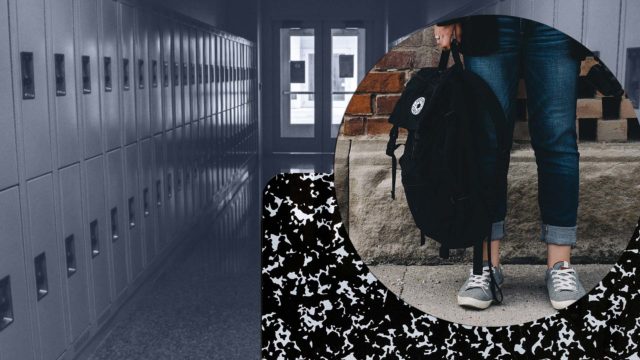
These research-backed approaches can help create safer schools and end gun violence.
Share Download PDF Print
America’s schools are among the safest places for children to be on a daily basis. But for the last 20 years, our students, educators, and parents have lived with rare yet devastating school shootings. This does not have to be. We can foster safe, supportive schools—free from gun violence—by addressing the factors that lead to violent incidents and implementing proven strategies that contribute to a healthy school climate.
This fact sheet lays out research-backed approaches for creating safer schools and ending gun violence that combine school-based interventions with strong gun safety laws. These actions work to intervene before shootings happen.
From 2013 through 2022, Everytown identified 720 incidents of gunfire on the grounds of a preschool or K–12 school, including incidents of gun homicides and assaults, gun suicides and attempts, unintentional shootings, and mass shootings. 1 For 10 full years beginning in 2013, Everytown collected detailed information on all incidents of gunfire on school grounds. Everytown defined incidents of gunfire on school grounds as “any time a gun discharges a live round inside (or into) a school building, or on (or onto) a school campus or grounds,” where “school” refers to a preschool; elementary, middle, and high schools—K–12—as well as colleges and universities. Of the 1,031 incidents identified at all schools between 2013 and 2022, 720 occurred on the grounds of a preschool, or elementary, middle, high, or K–12 school, resulting in 239 people killed and 504 people wounded. This analysis informs the lessons in this document. The analysis here reflects information related to gunfire on the grounds of preschools and K–12 schools only and is supplemented by external research. More information is available at https://everytownresearch.org/gunfire-in-school/ and https://everytownresearch.org/school-safety-plan.
School shooters usually have a connection to the school.
An Everytown analysis of the New York City Police Department’s review of active shooter incidents in K–12 schools over five decades found that the shooters were current or former students in 75 percent of these incidents. 2 New York City Police Department, “Active Shooter: Recommendations and Analysis for Risk Mitigation,” 2016, https://on.nyc.gov/2nWHM4O. The New York City Police Department (NYPD) defines an active shooter as “a person(s) actively engaged in killing or attempting to kill people in a confined and populated area.” In its definition, the Department of Homeland Security notes that, “in most cases, active shooters use firearm(s) and there is no pattern or method to their selection of victims.” Everytown limited its analysis of this data to incidents that took place in K–12 schools.
Guns used by shooters under age 18 usually come from the home.
Roughly three-quarters of school shooters under the age of 18 got the gun from their home or the home of a close relative.
“Protecting America’s Schools: A US Secret Service Analysis of Targeted School Violence”. National Threat Assessment Center. (2019). https://bit.ly/2U7vnwa
A US Secret Service analysis of nearly 40 years of school violence found that roughly three-quarters of school shooters’ guns came from the home of a parent or close relative. 3 National Threat Assessment Center, “Protecting America’s Schools: A US Secret Service Analysis of Targeted School Violence,” US Secret Service, Department of Homeland Security, 2019, https://bit.ly/2U7vnwa.
School shooters nearly always exhibit advance warning signs.
In all incidents of targeted school violence—100 percent—there were warning signs that caused others to be concerned. 4 National Threat Assessment Center, “Protecting America’s Schools: A US Secret Service Analysis of Targeted School Violence,” US Secret Service, Department of Homeland Security, 2019, https://bit.ly/2U7vnwa.
School gun violence has a disproportionate impact on students of color.
Two in three incidents of gunfire on school grounds from 2013 to 2021 occurred in schools where one or more racial and/or ethnic minorities constituted a majority of the student population. 5 Everytown Research analysis of Gunfire on School Grounds database, 2013 to 2021. Everytown for Gun Safety Support Fund, “How to Stop Shootings and Gun Violence in Schools: A Plan to Keep Students Safe, “ August 19, 2022, https://everytownresearch.org/school-safety-plan.
Gun violence prevention policies that will help to end school gun violence include:
4.6 million children in the United States live in homes with at least one gun that is loaded and unlocked.
Last updated: 3.11.2022
An estimated 4.6 million American children live in households with at least one loaded and unlocked firearm. 6 Matthew Miller and Deborah Azrael, “Firearm Storage in US Households with Children: Findings from the 2021 National Firearm Survey,” JAMA Network Open 5, no. 2 (2022): e2148823, https://doi.org/10.1001/jamanetworkopen.2021.48823. Secure storage and CAP laws hold gun owners accountable if a child can or does access firearms that are not securely stored. 7 Everytown for Gun Safety Support Fund, “Everytown Gun Law Rankings: Which States Have Child-Access and/or Secure Storage Laws?,” https://everytownresearch.org/rankings/law/secure-storage-or-child-access-prevention–required/. Since the vast majority of school shooters under age 18 acquire guns from the home, secure storage is an essential ingredient for preventing gun violence in schools.
This policy empowers family members, law enforcement, and, in some states, educators, to petition a civil court to temporarily prevent a person from accessing guns. Extreme Risk laws allow people in crisis times to get the help they need. As of April 2023, 19 states and the District of Columbia have enacted Extreme Risk laws. 8 For the most up-to-date list of states that have enacted Extreme Risk laws, visit https://everytownresearch.org/rankings/law/extreme-risk-law/. These laws are a vital tool for law enforcement in cases where a person who poses a risk to a school has access to firearms. 9 Everytown for Gun Safety Support Fund, “Extreme Risk Laws Save Lives: Stories,” March 13, 2023, https://everytownresearch.org/report/appendix-a-extreme-risk-laws-save-lives-stories/.
This policy can help block gun sales to teenagers. Data show that 18- to 20-year-olds commit gun homicides at triple the rate of adults 21 and older. 10 Everytown Research analysis using FBI Supplementary Homicide Report (SHR) and US Census American Community Survey data, 2016–2020.
Requiring background checks on all gun sales can prevent teenagers and prohibited persons from taking advantage of the background checks loophole, which allows people to buy a firearm online or at a gun show with no background check. 11 Everytown for Gun Safety Support Fund, “Everytown Gun Law Rankings: Which States Require Background Checks and/or Permits to Purchase Handguns?,” https://everytownresearch.org/rankings/law/background-check-and-or-purchase-permit/; Everytown for Gun Safety Support Fund, “Update Background Check Laws,” June 22, 2021, https://everytownresearch.org/report/update-background-check-laws/.
Students thrive in positive school environments. Supportive schools foster an affirming academic climate 12 National Center on Safe Supportive Learning Environments, “School Climate Improvement,” accessed April 21, 2023, https://safesupportivelearning.ed.gov/school-climate-improvement. while also creating conditions where children have adults with whom they feel safe asking for help or reporting concerning behavior. 13 Sandy Hook Promise, “Know the Signs Programs,” accessed April 21, 2023, https://bit.ly/2S9fgPa; Hsing-Fang Hsieh et al., “The Effectiveness of the Say-Something Anonymous Reporting System in Preventing School Violence: A Cluster Randomized Control Trial in 19 Middle Schools,” Journal of School Violence 21, no. 4 (2022), https://doi.org/10.1080/15388220.2022.2105858.

 pictured in the bottom left of the image. Two yellow-and-blue circles are superimposed on the image; one is at the bottom left, highlighting the father/daughter, and one is on the top right, highlighting the sign on the bus that reads " />
pictured in the bottom left of the image. Two yellow-and-blue circles are superimposed on the image; one is at the bottom left, highlighting the father/daughter, and one is on the top right, highlighting the sign on the bus that reads " />
Every day, more than 120 people in the United States are killed with guns, twice as many are shot and wounded, and countless others are impacted by acts of gun violence.
Everytown Research analysis of CDC, WONDER, Underlying Cause of Death, 2018–2022; Healthcare Cost and Utilization Project (HCUP) nonfatal firearm injury data, 2020; and SurveyUSA Market Research Study #26602, 2022.
Last updated: 5.7.2024
This website or its third-party tools use cookies and process personal data to ensure you get the best experience on our website.